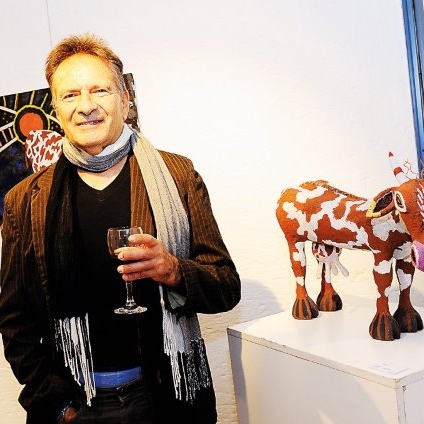
Featured Item

Hart to Heart
MATTHEW KROUSE
Hart is an artist of nature, and the style of his dramatic landscape paintings are clearly derived from such diverse sources as traditional aboriginal painters of Australia, San rock artists, and JH Pierneef. That’s not a bad place to start, but combined with a sense of adventure, he has created a style that is distinctly his own.
This is not to say that all the paintings in his exhibition, Trance Form, at the Art House Gallery in Melville, are about the natural world. One or two reference his city life. Going as far back as the early 1980s, there is a painting of his cat in the shadow of Hillbrow Tower, as well as a composition of scantily clad women he once saw at a club while dining with his wife in Joubert Park.
Hart worked at the nuclear physics research unit at the University of the Witwatersrand in his toiling years, but now regards himself as a full-time visual artist. “What I used to do,” he says, “is use nuclear techniques to interrogate rocks.”
He was appointed professor to prove that the renowned Vredefort crater, a Unesco (United Nations Educational, Scientific, and Cultural Organization) world heritage site, was actually caused by a meteorite. “It’s the biggest known crater,” Hart says; “but there could be another one under the Sahara Desert for all we know.
“This country is amazing, there are places here that tell us about the beginning of time. So, in Barberton, north of the Kruger Park, for example, there are these very old volcanic lava rock, probably the oldest in the world. And when you look at these, you can tell how the first rocks on earth came into being. It’s a place where you can trace the process of earth from the beginning of time to now.
“At 4.5 billion years old, they were in contact with sea water, and what you find in the cracks, where the sea water filtered into the rocks, are single-cell forms, showing life going back almost to the beginning of time.”
So, a level of deep exploration has led Hart to go beyond the surface of things. Yet in his artistic style, there is a naiveté at play, something to do with the way he improvises his perspective, forcing it into a rather flat picture plane.
His paintings are just one tributary of his creative life. The other is sculpture. Created of various factory made metals, gauzes, plaster, beads, and shreds of waxed African print, there are creatures aplenty making a menagerie of the wild. It’s an inedible delicatessen of animals in psychedelic hues.
Hart also creates prints on an iPad. In a process he attributes to the artist David Hockney, he begins with a pencil drawing, which he colours with his finger in a digital process. This is then printed on paper or light fabric.
In these ways, Hart’s art works are an urban thing.
“One of our big mistakes in the evolution of humankind is that we separated this urbanism [from] the natural world. As humankind, unless we learn to make space for animals and walk with them again, we are doomed.”
The show’s curator, Nira Sklair, said in her opening address, “Geology is still one of the most visual sciences as it is inextricably bound to the understanding of spatial relationships. Without spatial thinking, there is no geology.
“It can be well said that the origins of geology are located in a land of convergence between art and science.”
• Trance Form by Rodger Hart runs at the Art House Gallery, 67 4th Avenue, Melville, Johannesburg, until 13 June.




